The India , officially the Republic of India, is a country located in South Asia.
It is the 2nd most populated country on the planet and has the 7th world economy, but where huge social inequalities coexist.
General Data of India
- Capital : New Delhi
- Population : 1,281,935,911
- Demographic density : 92 inhabitants per km 2
- Surface : 3,287,000 km 2
- Government regime : parliamentary republic
- Head of State : Ram Nath Kovind, since July 25, 2017.
- Head of Government : Narendra Modi, since May 26, 2014.
- Language : Hindi and English and 21 more languages recognized by the federal administration. Some examples: Marathi, Nepalese, Tamil and Urdu.
- Currency : Indian rupee
- GDP : $ 2.264 trillion (2016)
- HDI : 0.624
- Religion : Hinduism, Islam, Sikhism, Buddhism, Christianity.
Flag of India
The Indian flag is formed by three horizontal bands in green, white and saffron. In the center, on the white band, in navy blue, is the Wheel of Dharma, symbol of Hinduism.
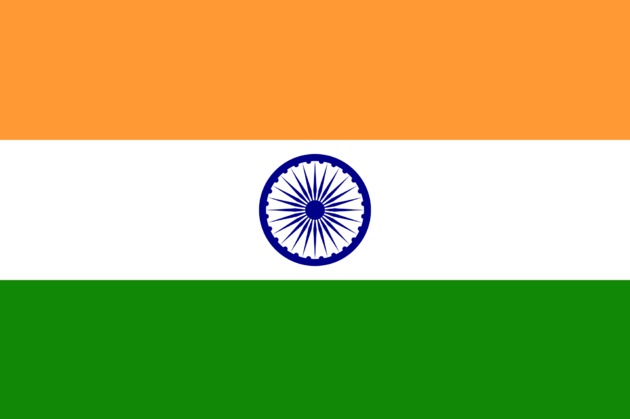
India map
India borders the following countries:
- Pakistan
- Nepal
- Bangladesh
- China
- Bhutan
- Burma
The country is bathed by the Indian Ocean .
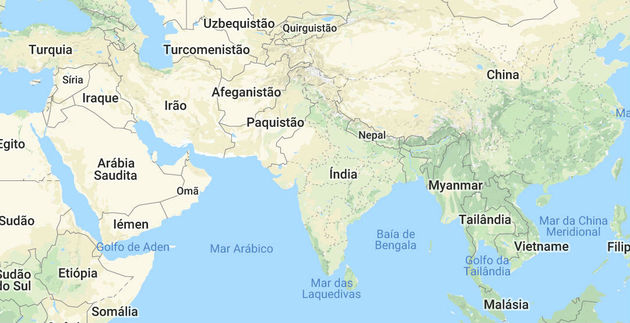
Territorial Division of India
India is divided into 28 states and 7 federal territories:
- Andhra Pradesh
- Arunachal Pradesh
- Assam
- Bihar
- Chhattisgarh
- Goa
- Gujarat
- Haryana
- Himachal Pradesh
- Jammu and Kashmir
- Jharkhand
- Karnataka
- Kerala
- Madhya Pradesh
- Maharashtra
- Manipur
- Meghalaya
- Mizoram
- Nagaland
- Orissa
- Panjabe
- Rajasthan
- Siquim
- Tamil Nadu
- Tripura
- Uttar Pradesh
- Uttarakhand
- West Bengal
Federal Territories
- Andaman and Nicobar
- Chandigarh
- Dadrá and Nagar Haveli
- Daman and Diu
- Laquediva
- Delhi
- Pondicherry
Territorial Dispute
Since independence, in 1947, the country has disputed the Kashmir region, with China and Pakistan. When the English left the country, they formed two territories according to the religious majority of each. Thus, India appears, with a majority Hindu and Pakistan, where a large part professes Islam.
However, that small part of the territory, rich in water sources and fertile land for agriculture, was claimed by neighboring countries.

Culture of India
As a large country and home to a multitude of different religions and languages, Indian culture is varied. We still have to add the customs of European colonists, especially British, who were incorporated into the daily life of the Indian.
Dance
Dance expresses happiness. If a person is happy, he dances. That simple. That is why Bollywood films always end with choreographed and very cheerful balls.
One of the oldest dance styles in the world is the Indian Bharatanatyam whose material evidence dates back to 3000 BC This dance was initially practiced by women who used religious postures during their performances.
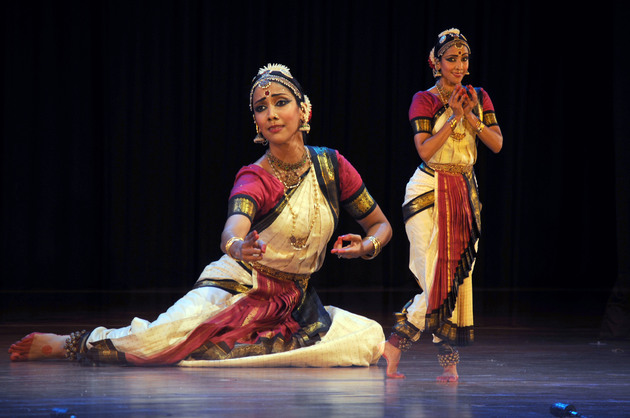
Currently, men and women practice Bharatanatyam, however, they never touch each other while they are doing the steps.
Music
Indian music is the result of a mixture of chants by Buddhist monks, field workers, and Muslim prayers.
In the midst of this cultural mix, the melodies are full of intervals and ornaments, which are accompanied by drums such as mridangam and tabla .
Musical instruments such as tambura and sitar also stand out , popularized in the West through the performances of Ravi Shankar (1920-2012). This musician made Indian melodies known through his collaborations with Western artists such as the Beatles and the Rolling Stones.
Literature
Initially, Indian literature was linked to religion and oral tradition. Thus, several poems told the lives of the gods and their relationship with human beings.
Among the main examples are the Vedas (3,500 BC), Ramayana and Mahabharata (4th and 5th centuries AD), Kathasaritsagara (9th century).
From the English colonization, especially in the Calcutta region, the Indians came to have contact with new forms of writing such as the novel. Writing in English, they began to spread Indian history and customs to Westerners.
They quickly won their place in the western canon. Writers such as Rabindranath Tagore (1861-1941) and Rudyar Kypling (1865-1936) are located on the border between East and West, the spiritual and the material, the metaphor of the meeting of the two worlds. Kipling created Mogli, the wolf-boy, making him a character in the western imagination.
Both won the Nobel Prize for Literature when India was under British rule.
economy
After Independence from India in 1947, the country was classified as an underdeveloped country, but with enormous potential due to the size of its territory and its population.
In the 21st century, India opened up to the world and uses this fact to gain more space on the international stage. With Brazil, China, Russia and South Africa, it formed the BRICS bloc where the most promising economies on the planet are gathered.
The graph below shows the growth of the Indian Gross Domestic Product (GDP) in the first two decades of the 21st century:
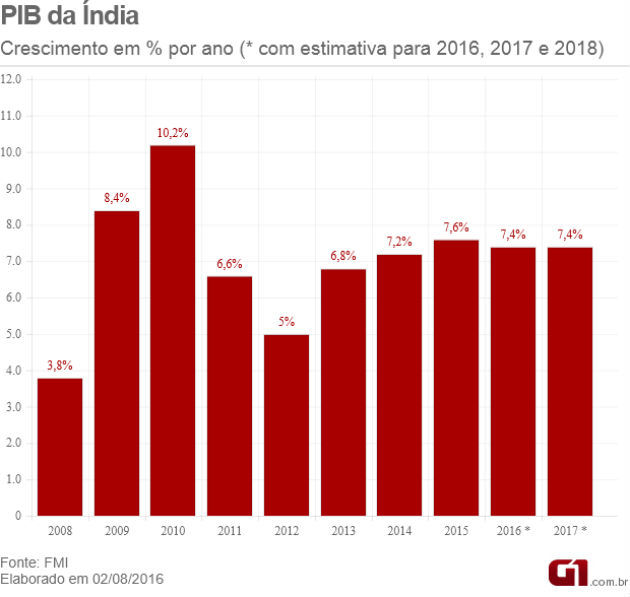
It is the 2nd country, just behind the USA, that trains more computer engineers and its film industry, Bollywood, is the largest in the world.
However, social inequality remains frightening. India has 1.3 billion people and 100 million millionaires.
Per capita income is $ 1,709.39, which puts it at rank 148, out of a list of 196 countries.
Disorganized growth harms the environment and has caused many cities to suffer from pollution. A clear example is New Delhi, the most populated city in India, the 5th in the world and the most polluted on the planet. It is permanently covered with a haze of pollution.
Tourism
Another important industry for Indians is tourism, which accounts for 6.8% of the country’s GDP. About 10 million tourists visit India every year to see monuments like the Taj Mahal or natural attractions like the Ganges river .
There is also an important contingent attracted by religious tourism who come to meditate in monasteries, participate in celebrations such as Diwali or Holi (Festiva das Cores).
History of India
The Indian sub-continent is home to one of the oldest civilizations on the planet. There is evidence of human occupation in 75,000 years before Christ.
The territory was divided by small kingdoms ruled by Maharajas who allied or fought according to political and military conveniences.
Trade with the West has always existed through the caravans that made the silk and spice route. Indian products were very popular in Europe.
In the 16th century, the Portuguese arrived on the Indian coast, negotiated treaties with local leaders and founded the city of Goa. They would remain there for almost four centuries until the Indian national state was constituted in 1947.
English colonization in India
However, during the 19th century, the British conquered and occupied India. In a short time, the territory becomes the “crown jewel”, one of the main destinations for unemployed Britons and a source of raw material for the English Industrial Revolution.
The marks of colonization are felt with English being the common language used by the federal administration. Likewise, sports such as cricket and horse racing are enjoyed by Indians due to British customs.
On the other hand, the Indians did not accept British domination peacefully. The Cipaios Revolt made it clear that part of the population did not want them there.
After the First World War, within the decolonization movement, the British had to negotiate their departure with different political and religious groups.
One of the great leaders of that time was Gandhi who, together with Jawaharlal Nehru (1889-1964), managed to make the country’s independence relatively peaceful.
Curiosities
- Despite being banned, India continues with the caste system . Therefore, certain professions can only be exercised by those who were born in a certain caste.
- The cow is a sacred animal for Hinduism because it refers to prosperity and the guarantee of work.
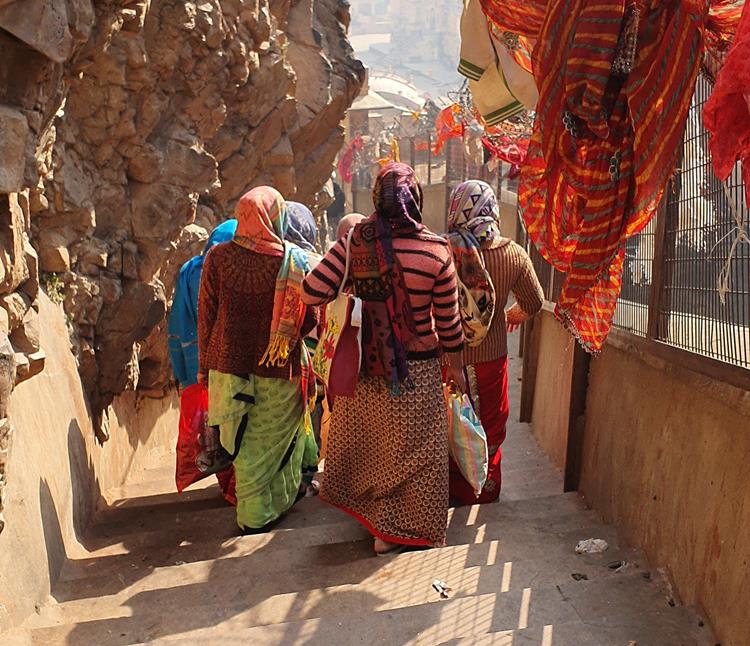
The system divided people according to their social position. There were more than 3,000 different grape varieties in India, resulting from the subdivisions of the four classic grape varieties. The main grape varieties were:
- the Brahmins, which included priests, teachers, religious and nobles,
- the Xatrias, considered warriors
- the vaixias, where were the merchants and farmers
- the sudras, who were peasants, artisans and workers
There were still outcasts or dalits who were considered without caste. Hindus believed that they were not born of the god Brahma and, therefore, should be discriminated against.
Effect of Covid-19 on India’s Economy
The India was in its ascendancy. For years, the country has remained among the three or four fastest growing economies in the world, according to a survey by The Economist magazine , lifting millions
of Indians out of poverty, building modern megacities and accumulating geopolitical assets. Experts hoped that one day it could rival China , Asia’s biggest success story.
However, his bright future is in danger. The The Economist now estimates that the poly-position earlier, India has fallen to 35th place among the 42 nations fastest growing in 2020, shrinking more rapidly than any other major economy. Due to the coronavirus crisis , about 200 million people can go into poverty, according to the American newspaper The New York Times .
Indian economic growth was already slowing down before the pandemic . The growth rate went from 8% in 2016 to 4% in 2019, but the situation was aggravated by the lockdown imposed by the Prime Minister of India, Narendra Modi , on the population of 1.3 bil Without sanitary effectiveness, the measure both hurt the economy and spread the virus. India is now the country where Covid-19 spreads the fastest, with more than 80,000 new infections reported every day
